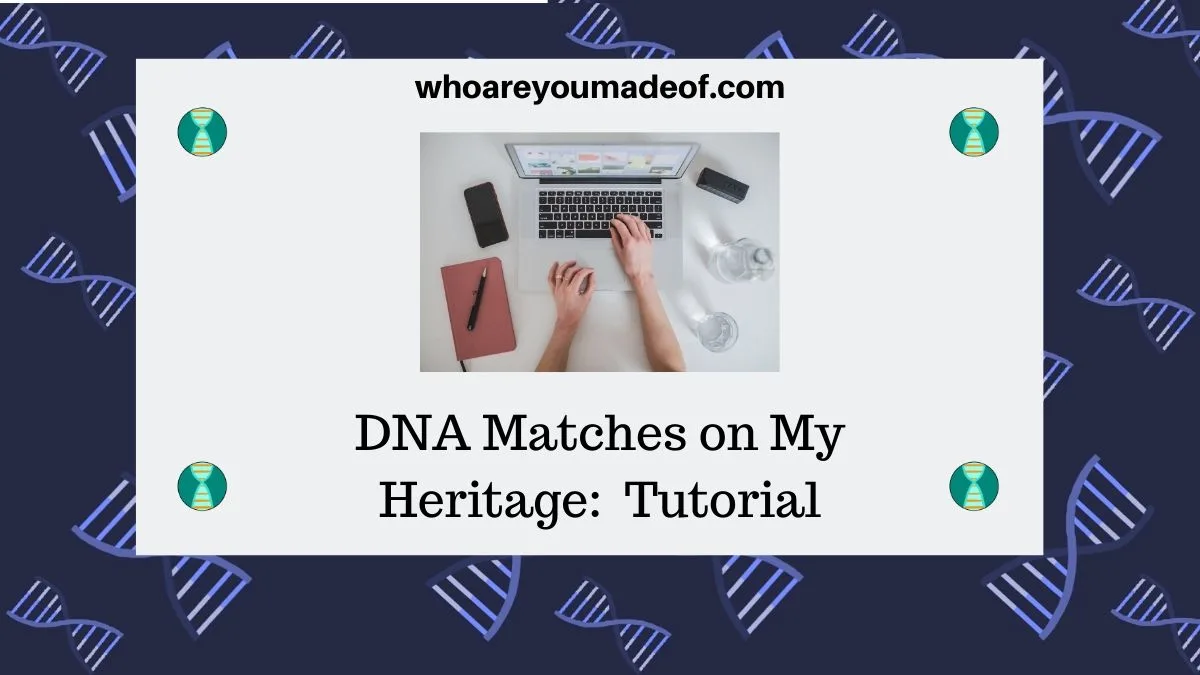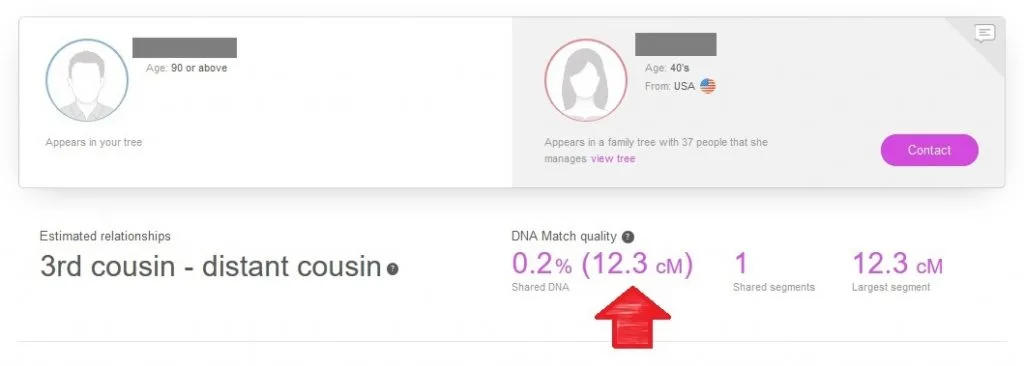Did you do your DNA with My Heritage? In this post, learn how to understand your DNA matches, find out how you are related, and more.
My Heritage offers a great DNA test. If you didn't originally do your DNA test with them, you can upload your raw DNA file from other sites in order to get My Heritage DNA results.
My favorite aspect of My Heritage DNA results are the DNA matches. In fact, it's the best DNA match list out there.
It's easy-to-use, and with the tips that I give you in this post, you'll have no trouble understanding your DNA matches.

What are DNA matches?
When My Heritage tests your DNA, they compare your DNA to that of other people who have done DNA tests with My Heritage. In addition, they compare your DNA to those people who have uploaded their DNA files from other testing companies.
If your DNA matches any of these individuals, they will show up on your DNA match list. These people are your DNA matches.
My Heritage has an advanced algorithm that can detect identical pieces of DNA, called DNA segments. You might share many pieces of DNA with some of your DNA matches, and as few as one piece with others.
Your DNA matches on My Heritage can be closely or distantly related.
What can you learn from My Heritage DNA matches?
Your My Heritage DNA match list is filled with valuable information. You can discover new living relatives, learn about new ancestors, and uncover important details about your family tree.
In fact, your DNA matches can be a useful tool for family tree research. If you are interested in genealogy, you should not overlook your DNA match list.
In order to learn all you can from your DNA matches, there are important aspects of your connection with each match that you should examine.
Five things you should look for in every DNA match
Fortunately, My Heritage has made it super easy for you to navigate through your DNA match list to learn more about your connection with your matches.
There are five main aspects of your DNA match list that I recommend you investigate each time you examine a DNA match: total shared DNA, size of largest segment, family tree information, shared matches, and shared ethnicity regions.
Below, I will explain more about each element and what you can learn by working through your matches in a methodical manner.
I would recommend starting at the top of your DNA match list with your closest DNA matches. As time permits, you can work down your list learning about your more distant relatives.
Total shared DNA
One of the most important things we should look for when we examine a match on My Heritage is the total amount of shared DNA. You can see this information directly from your main match list, or when you click on your match's name to view more about the connection.
Below, you can see an example of a DNA match from My Heritage. These individuals share 12.3 cMs (centimorgans) of DNA.

The number of shared centimorgans can help us estimate our relationship to our DNA matches.
Size of largest segment
The next important piece of information is the size of the largest DNA segment. This is especially important if you don't already know how you are related to your DNA match.
We inherit large pieces of DNA from our parents, and over the generations, DNA segments get broken-up.
This means that people who share very large segments with us are likely relatively close relatives. Those DNA matches who share very small segments could be very distantly related.
How do you know what a large segment is? And how small is a small segment?
While there is no hard and fast rule about DNA segment sizes, you can use the following as a general guide:
- Less than 12 cMs = small
- Between 12-50 cMs = medium
- Between than 50-100 cMs = large
- Longer than 100 cMs = very large
The DNA match that I showed as an example above shares only 12.3 cMs, which is barely in the medium category. In fact, I would call it a small segment.
It is unlikely that the common ancestor is more recent than great-great grandparent. In addition, it's important to know that with segments this small, the common ancestor could be further than eight generations back.
Family tree information
As you now know, the amount of shared DNA can give you an idea about where you should look in your tree (and your match's tree) for a common ancestor.
Appropriately, this is the next element of your DNA match list that you should check. On My Heritage, you can access several generations of your DNA match's family tree right from the match profile page.
If you scroll about ⅔ down the page, you will find a section called "Pedigree Charts". This is where you will find your match's family tree, if they have built one on My Heritage.
If there is no family tree attached to your DNA match's profile, then you might want to read my post: "How is your DNA match related? Here's a Checklist."
Other DNA matches shared in common
The further back you go in someone's family tree, you might notice that the number of ancestors grows quickly. If only there was some way to narrow down the options a bit and eliminate some lines of your family tree as places to look for a connection.
If you check your shared DNA matches, you will be able to see which matches you share in common with your DNA match.
This will often help you figure out on which side of your family you should look to find your connection. This is especially true if you have close relatives who have also tested with My Heritage.
You can find the Shared DNA Matches right before the family tree (Pedigree Charts) section of the DNA match profile:

All of the people who are in the Shared DNA Matches list share DNA with both you and your DNA match.
It's important to note that it is possible that you and your DNA match are related to some of your Shared DNA Matches in different wants. This is especially likely with more distant matches.
Ethnicity regions in common
The final element that you should should check is the shared ethnicity regions. This is the next-to-last section of your DNA match's profile page.
You can sometimes examine your shared ethnicity regions in order to narrow down ways in which you and your match might be related.
Conclusion
I hope that this post has helped you understand more about your My Heritage DNA matches. In addition, my goal was that you would be excited to explore your matches to find out what you can learn.
If you have any questions about something that you read in this post, or if you would like to share a specific question about your DNA match list, I would love to hear from you in the discussion below.
Thanks for stopping by today!


Vivienne
Sunday 12th of December 2021
I have had a dna result of my sister. Which is 186.5 cm, shared segments 44 and shared dna 35%. Would she be a full sister or a half sister to me.
JoanJoJoan
Monday 22nd of June 2020
Hi Mercedes, When my match indicates an estimated relationship and I know what the relationship is, is there a way to confirm that relationship on my list of matches? Am I able to connect that individual to the person in my tree on my My Heritage tree? Thank you for your help. Joan
Pamela Beamand
Sunday 21st of June 2020
Hi Mercedes, if I leave a query here about how a group of similar DNA matching people are related, does it remain private or is in the public domain? Love your posts, very informative and easy to read.
Mercedes
Monday 22nd of June 2020
Hi Pamela, The comments that are left on the site are public for readers to see, although I can certainly delete comments upon request. If you want to contact me privately, you can e-mail me at mercedes @ whoareyoumadeof.com. I appreciate your kind words and am glad you find the articles helpful! Sincerely, Mercedes